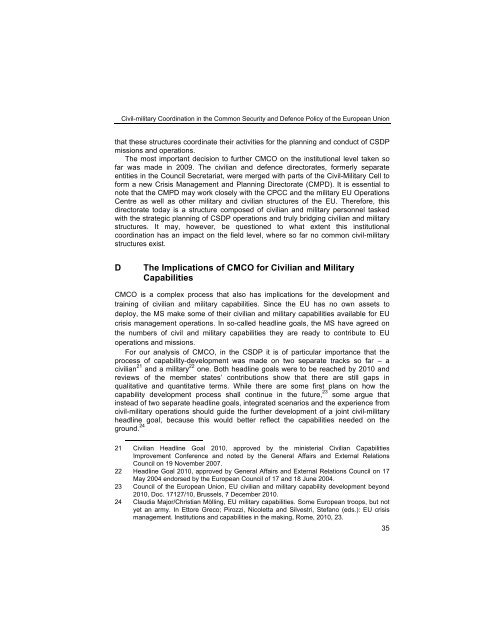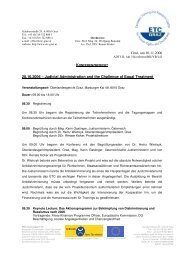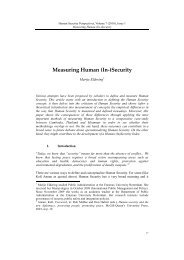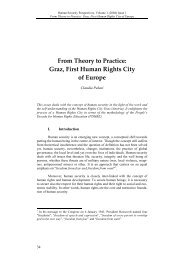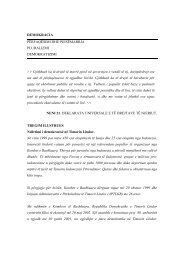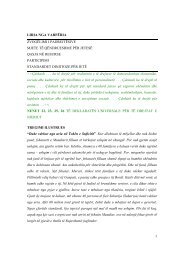Civil-military Coordination in the Common Security and ... - ETC Graz
Civil-military Coordination in the Common Security and ... - ETC Graz
Civil-military Coordination in the Common Security and ... - ETC Graz
You also want an ePaper? Increase the reach of your titles
YUMPU automatically turns print PDFs into web optimized ePapers that Google loves.
<strong>Civil</strong>-<strong>military</strong> <strong>Coord<strong>in</strong>ation</strong> <strong>in</strong> <strong>the</strong> <strong>Common</strong> <strong>Security</strong> <strong>and</strong> Defence Policy of <strong>the</strong> European Union<br />
that <strong>the</strong>se structures coord<strong>in</strong>ate <strong>the</strong>ir activities for <strong>the</strong> plann<strong>in</strong>g <strong>and</strong> conduct of CSDP<br />
missions <strong>and</strong> operations.<br />
The most important decision to fur<strong>the</strong>r CMCO on <strong>the</strong> <strong>in</strong>stitutional level taken so<br />
far was made <strong>in</strong> 2009. The civilian <strong>and</strong> defence directorates, formerly separate<br />
entities <strong>in</strong> <strong>the</strong> Council Secretariat, were merged with parts of <strong>the</strong> <strong>Civil</strong>-Military Cell to<br />
form a new Crisis Management <strong>and</strong> Plann<strong>in</strong>g Directorate (CMPD). It is essential to<br />
note that <strong>the</strong> CMPD may work closely with <strong>the</strong> CPCC <strong>and</strong> <strong>the</strong> <strong>military</strong> EU Operations<br />
Centre as well as o<strong>the</strong>r <strong>military</strong> <strong>and</strong> civilian structures of <strong>the</strong> EU. Therefore, this<br />
directorate today is a structure composed of civilian <strong>and</strong> <strong>military</strong> personnel tasked<br />
with <strong>the</strong> strategic plann<strong>in</strong>g of CSDP operations <strong>and</strong> truly bridg<strong>in</strong>g civilian <strong>and</strong> <strong>military</strong><br />
structures. It may, however, be questioned to what extent this <strong>in</strong>stitutional<br />
coord<strong>in</strong>ation has an impact on <strong>the</strong> field level, where so far no common civil-<strong>military</strong><br />
structures exist.<br />
D The Implications of CMCO for <strong>Civil</strong>ian <strong>and</strong> Military<br />
Capabilities<br />
CMCO is a complex process that also has implications for <strong>the</strong> development <strong>and</strong><br />
tra<strong>in</strong><strong>in</strong>g of civilian <strong>and</strong> <strong>military</strong> capabilities. S<strong>in</strong>ce <strong>the</strong> EU has no own assets to<br />
deploy, <strong>the</strong> MS make some of <strong>the</strong>ir civilian <strong>and</strong> <strong>military</strong> capabilities available for EU<br />
crisis management operations. In so-called headl<strong>in</strong>e goals, <strong>the</strong> MS have agreed on<br />
<strong>the</strong> numbers of civil <strong>and</strong> <strong>military</strong> capabilities <strong>the</strong>y are ready to contribute to EU<br />
operations <strong>and</strong> missions.<br />
For our analysis of CMCO, <strong>in</strong> <strong>the</strong> CSDP it is of particular importance that <strong>the</strong><br />
process of capability-development was made on two separate tracks so far – a<br />
civilian 21 <strong>and</strong> a <strong>military</strong> 22 one. Both headl<strong>in</strong>e goals were to be reached by 2010 <strong>and</strong><br />
reviews of <strong>the</strong> member states’ contributions show that <strong>the</strong>re are still gaps <strong>in</strong><br />
qualitative <strong>and</strong> quantitative terms. While <strong>the</strong>re are some first plans on how <strong>the</strong><br />
capability development process shall cont<strong>in</strong>ue <strong>in</strong> <strong>the</strong> future, 23 some argue that<br />
<strong>in</strong>stead of two separate headl<strong>in</strong>e goals, <strong>in</strong>tegrated scenarios <strong>and</strong> <strong>the</strong> experience from<br />
civil-<strong>military</strong> operations should guide <strong>the</strong> fur<strong>the</strong>r development of a jo<strong>in</strong>t civil-<strong>military</strong><br />
headl<strong>in</strong>e goal, because this would better reflect <strong>the</strong> capabilities needed on <strong>the</strong><br />
ground. 24<br />
21 <strong>Civil</strong>ian Headl<strong>in</strong>e Goal 2010, approved by <strong>the</strong> m<strong>in</strong>isterial <strong>Civil</strong>ian Capabilities<br />
Improvement Conference <strong>and</strong> noted by <strong>the</strong> General Affairs <strong>and</strong> External Relations<br />
Council on 19 November 2007.<br />
22 Headl<strong>in</strong>e Goal 2010, approved by General Affairs <strong>and</strong> External Relations Council on 17<br />
May 2004 endorsed by <strong>the</strong> European Council of 17 <strong>and</strong> 18 June 2004.<br />
23 Council of <strong>the</strong> European Union, EU civilian <strong>and</strong> <strong>military</strong> capability development beyond<br />
2010, Doc. 17127/10, Brussels, 7 December 2010.<br />
24 Claudia Major/Christian Möll<strong>in</strong>g, EU <strong>military</strong> capabilities. Some European troops, but not<br />
yet an army. In Ettore Greco; Pirozzi, Nicoletta <strong>and</strong> Silvestri, Stefano (eds.): EU crisis<br />
management. Institutions <strong>and</strong> capabilities <strong>in</strong> <strong>the</strong> mak<strong>in</strong>g, Rome, 2010, 23.<br />
35


